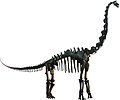A holotype (Latin: holotypus) is a single physical example (or illustration) of an organism used when the species (or lower-ranked taxon) was formally...
6 KB (779 words) - 07:30, 6 September 2024
Type (biology) (section Holotype)
nomenclatural type when there was no holotype specified or the holotype has been lost or destroyed isotype – a duplicate of the holotype syntype – any specimen (or...
32 KB (4,186 words) - 07:05, 28 August 2024
Marsh, but more likely was used solely for display. The first specimen, holotype USNM 4735, was discovered and excavated by farmer Marshall Parker Felch...
84 KB (9,734 words) - 18:52, 14 September 2024
Museum of Natural History Stuttgart. In 1996, the specimen became the holotype of the type species Irritator challengeri. The genus name comes from the...
95 KB (10,487 words) - 08:58, 12 April 2024
Brachiosaurus (section Holotype specimen)
and 22 meters (59 and 72 ft) long; body mass estimates of the subadult holotype specimen range from 28.3 to 46.9 metric tons (31.2 to 51.7 short tons)...
120 KB (14,417 words) - 05:05, 11 October 2024
area in New South Wales, Australia. It is currently only known from the holotype specimen. Grevillea milleriana is a low, spreading, sub-prostrate shrub...
4 KB (437 words) - 09:03, 6 October 2024
Late Cretaceous period, approximately 99.6 to 95 million years ago. The holotype specimen was discovered in the Candeleros Formation of Patagonia in 1993...
58 KB (6,872 words) - 22:05, 27 May 2024
Livyatan (section Holotype and naming)
preserved skull, as well as teeth and the lower jaw, belonging to L., the holotype specimen MUSM 1676, were discovered in the coastal desert of Peru in the...
53 KB (5,887 words) - 19:03, 8 October 2024
birds known to demonstrate semi-aquatic adaptations. The Shuilingornis holotype specimen, LY2022JZ3002, was discovered in sediments of the Jiufotang Formation...
5 KB (331 words) - 15:27, 6 October 2024
mammal, though its size may have been historically overestimated. The holotype of Andrewsarchus mongoliensis, a mostly-complete cranium (AMNH-VP 20135)...
21 KB (1,913 words) - 08:47, 11 October 2024










